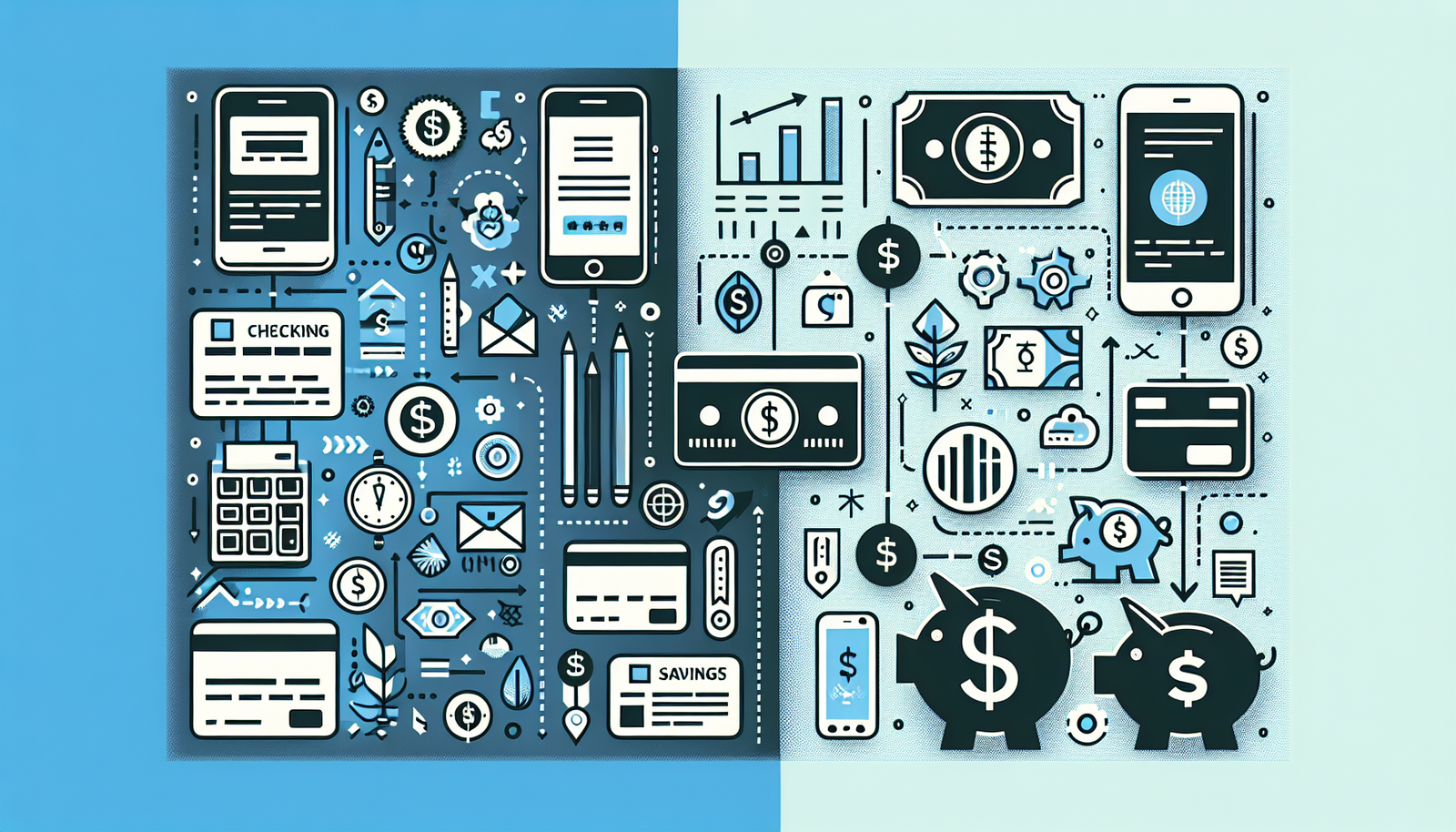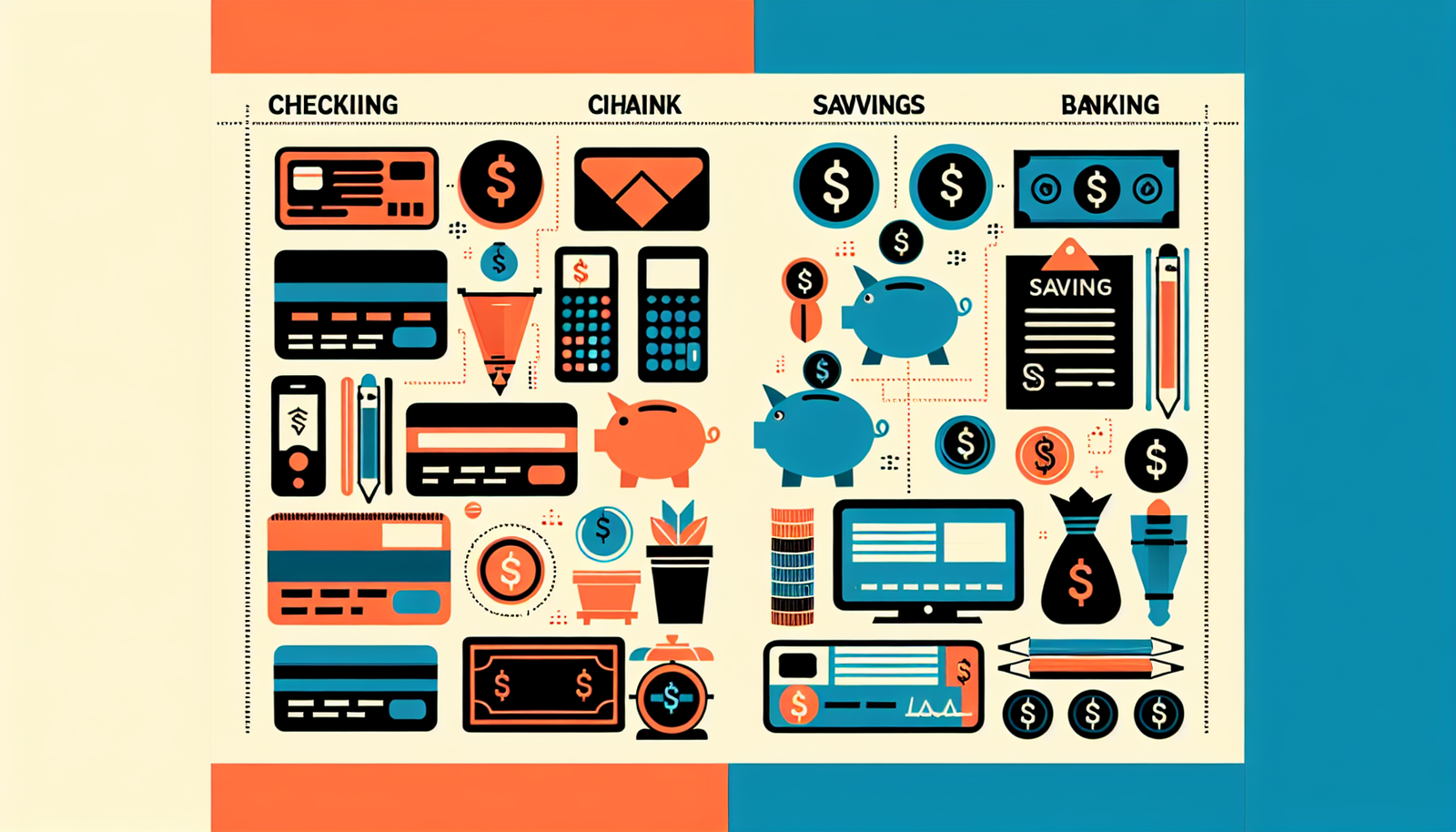
Imagine yourself entering through the high, polished glass doors of a bustling bank, its cool air brimming with the whispers of countless money conversations. You’re there on a mission – a financial mission. You’ve decided it’s time to upgrade from a piggy bank on your dresser to something more secure and empowering—a real bank account. But then the looming question ambushes you: should you go for a checking or a savings account? Finding your footing in the economic world can be like navigating a labyrinth, but by the end of this article, you’ll have grasped the fundamental differences between checking and savings accounts. Glide through the maze of banking jargon with ease and aplomb, and stride into your financial future with confidence.
Understanding the Basics of Checking Accounts
Definition of Checking Account
Let’s start our voyage into the banking world with a basic stop – the checking account. Picture it as the busy bee of your financial ecosystem. A checking account is a deposit account held at a financial institution that allows deposits and withdrawals. Basically, it’s your go-to account for everyday transactions.
Purpose of Checking Accounts
Now, why would you need a checking account? Imagine planning a fabulous dinner party. You’ll need a place where everyone gathers, socializes, and listens to your tales of fiscal wizardry – that’s your checking account. It’s designed for frequent use, allowing you to receive your salary, pay your bills, swipe your debit card for that coveted latte.
Key Features of Checking Accounts
Checking accounts come with a digital smorgasbord of features. They often include an unlimited number of deposits, check writing, and electronic transfers. Not to forget, debit cards, which play a significant role in today’s cashless society. Wrap these all up with online and mobile banking, and you’ve got yourself a checking account!
Understanding the Basics of Savings Accounts
Definition of Savings Account
As we journey further into the realm of banking, we come across a rather prudent character – the savings account. A depository account, the savings account is a place where you stash away funds that you do not need for daily expenses but want to keep for future use. It’s like a treasure chest protected by a fierce dragon (the bank) that guards your gold.
Purpose of Savings Accounts
So why create a savings account? Think of it as your personal genie’s lamp, holding that special savings magic. It’s designed to help you grow your wealth, bit by bit. When you stash funds into it and let it sit, it can collect interest, thus fitting perfectly into your long-term financial plans and acting as a safety net for unexpected costs.
Key Features of Savings Accounts
Savings accounts, while more guarded than checking accounts, provide their own set of benefits. These include earning interest on your account balance, a safe and FDIC-insured place to store your money, and a limit on monthly transactions. While this limit might initially seem restrictive, it actually encourages users to leave the money in the account, letting it grow and flourish.

Primary Differences Between Checking and Savings Accounts
Comparison between Checking and Savings Accounts
Checking and savings accounts are like yin and yang – different, yet complementary. A checking account is designed for regular transactions – it’s the kitchen where all the cooking happens. In contrast, a savings account is more like a pantry where you store extra food items for later use – the less you take out, the more you’ll have stocked away when you need it.
How the accounts are designed to be used differently
As each account serves its purpose, they’re crafted differently. Checking accounts, for daily use, offer more flexibility with transactions but rarely offer interest. Then we have savings accounts, designed for minimal access, offering interest on the balance but limiting transactions.
The key differentiation factors between the two accounts
The devil is in the details, they say. The primary differences lie in transaction limits, interest rates, and the purpose each account serves. Checking accounts are for daily, transactional use, and savings accounts are for building or accumulating wealth, a process that’s encouraged through interest-earning.
Accessibility of Funds
Accessibility of Funds in Checking Accounts
With checking accounts, you can easily access funds like an eager artist armed with a paintbrush. You can withdraw through checks, ATMs, electronic transfers, debit cards, or in-person at the bank.
Accessibility of Funds in Savings Accounts
On the flip side, savings accounts, like an exclusive art gallery, limit access. You’ll enjoy interest accumulation, but federal regulation restricts you to six transactions per month. Any more can lead to fees or even account closure.
Differences in Accessibility between Checking and Savings Accounts
The difference in accessibility is akin to an open book versus a locked diary. Checking accounts are open for frequent transactions, while savings accounts have barriers to frequent access, encouraging saving behaviors.

Interest Rates
Interest Rates in Checking Accounts
For checking accounts, interest is almost as elusive as a chameleon in a leafy forest – while some do offer interest, most often do not.
Interest Rates in Savings Accounts
Savings accounts, however, are designed to reward your patience, offering interest on your balance – like finding a pot of gold at the end of the rainbow.
Comparing the Interest Rates of Both Accounts
While most checking accounts don’t offer interest, savings accounts typically do, leading to accumulated wealth over time. Thus, in the race of interest earning, the savings account takes the trophy.
Maintenance and Service Fees
Typical Maintenance and Service Fees for Checking Accounts
When it comes to fees, checking accounts could potentially be a mixed bag. Some may command monthly maintenance fees, minimum balance fees, and overdraft fees; however, not all, especially those in online banks.
Typical Maintenance and Service Fees for Savings Accounts
Savings accounts can also carry fees – like minimum balance fees and excess withdrawal fees. However, if you stick to your plan of making banking’s equivalent of honey (saving and avoiding unnecessary transactions), you’ll find yourself avoiding these stings.
Comparison of Maintenance and Service Fees for both Accounts
Checking and savings accounts alike can incur fees, but the types often differ. The trick is to avoid them by maintaining minimum balances, limiting transactions, and managing your finances wisely.
Transaction Limits
Transaction Limits in Checking Accounts
Have you ever been to an all-you-can-eat buffet? Checking accounts are the financial equivalent of such a feast, offering an unlimited number of transactions.
Transaction Limits in Savings Accounts
In stark contrast, savings accounts present a carefully portioned gourmet meal, limiting you to six transactions per month.
Difference in Transaction Limits Between Checking and Savings Accounts
The differences in transaction limits here are like night and day – the checking account’s high transaction allowance makes it your hero for daily financial activities, while the limited transactions in a savings account make it the foundation of your long-term savings plan.
Penalties and Overdraft Protections
Penalties and Overdraft Protections in Checking Accounts
Checking accounts offer overdraft protection, a service that covers expenses when you’re short on funds. However, this isn’t a free ride, and you could face hefty overdraft fees per transaction.
Penalties and Overdraft Protections in Savings Accounts
As for savings accounts, the key penalties relate to exceeding the six transactions per month – exceed this, and you might be hit with a fee or even have the account closed.
Comparing Penalties and Overdraft Protections of Both Accounts
Both accounts have penalties and advantages. Checking accounts often provide overdraft protections but accompany fees, while savings accounts penalize you for excessive transactions. So, while you paint your financial canvas, keep these policies in mind.
Use Cases for Checking and Savings Accounts
Typical Use Cases for Checking Accounts
Checking accounts are like your financial Swiss Army Knife – they’re excellent for your general, day-to-day transactions, such as receiving salaries, paying bills, and using ATM and debit cards.
Typical Use Cases for Savings Accounts
Savings accounts, on the other hand, are like your precious piggy bank. They’re best for stashing away money for future expenses or emergencies and for earning interest over time.
How Use Cases Vary Between Checking and Savings Accounts
While checking accounts serve to support daily spending and transactions, savings accounts foster wealth-building and provide a safety net for unforeseen events. It’s the classic story of the tortoise and the hare – one is for the fast-paced, immediate requirements, while the other is for the slow and steady winning of the wealth race.
Choosing Between Checking and Savings Accounts
Factors to Consider When Choosing Between Checking and Savings
When choosing between checking and savings accounts, it’s essential to consider your personal financial goals. Do you need a transactional account for everyday use, or an account to help build your savings? Understanding their differences and your needs is the key to unlocking which is best for you.
The Ideal Account Based on Financial Goals
If your goal is to have an account for routine banking transactions, the checking account is your knight in shining armor. If you want to grow savings and earn interest, then the savings account, your trusty steed, is your companion.
Recommendations for Choosing the Right Account
Remember, checking and savings accounts are not mutually exclusive – they can both have a part to play in managing your finances. The best storybook ending? Harness the power of both accounts. Use your checking account for everyday transactions and let your savings account accumulate wealth. With this dual power approach, you’ll be orchestrating your own financial symphony!

